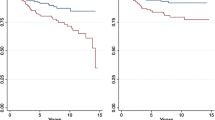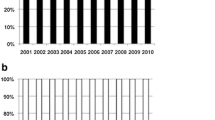Abstract
Background
Surgery is the most important treatment for nonmetastatic breast cancer; however, the utilization of modern surgical techniques in management of breast cancer in mainland China has not been reported.
Methods
The medical records of 5887 consecutive breast cancer patients treated surgically in the past 16 years were reviewed retrospectively; the utilization of different surgical modalities and associated clinical outcomes were analyzed.
Results
Median age of all patients was 50 (range 16–92). About 1015 patients were staged as 0–I, 3569 stage II, 517 stage III, and 786 cases could not be staged. Extensive radical mastectomy (ERM), radical mastectomy (RM), modified radical mastectomy (MRM), simple mastectomy (SM), and breast-conserving surgery (BCS) were used in 8%, 27.2%, 55.7%, 1.5%, and 6.3% of patients, respectively. In addition, 1.3% of patients received breast reconstruction. The proportion of early-stage breast cancer increased, and the surgery patterns varied. MRM gradually replaced ERM and RM. The prevalence of BCS began to increase from the mid-1990s and currently represents about 12%. The prevalence of reconstruction also increased and now accounts for 5%. Age, pathologic pattern, and TNM staging affected the choice of surgery modalities markedly. Although patients receiving RM/ERM had worse survival than those receiving BCS/MRM, the survival outcomes of these four groups were similar in the early-stage population.
Conclusions
MRM remains the most-used surgical modality in operable breast cancer, although the utilization of BCS for early-stage disease has increased rapidly in last decade. Reconstruction following mastectomy as an alternative to BCS is available. Breast-conserving therapy (BCT) and MRM provide similar local controls and long-term survival for breast cancer. Selection of appropriate candidates for a certain surgery requires an assessment of the patient’s age and clinical and pathological characteristics of the tumor.






Similar content being viewed by others
References
Jemal A, Siegel R, Ward E, et al. Cancer statistics, 2006. CA Cancer J Clin 2006; 56:106–130
Parkin D, Bray F, Ferlay J, Pisani P. Global cancer statistics, 2002. CA Cancer J Clin 2005; 55:74–108
Yang L, Parkin DM, Ferlay J, Li L, Chen Y. Estimates of cancer incidence in China for 2000 and projections for 2005. Cancer Epidemiol Biomarkers Prev 2005; 14:243–50
Newman LA. Locoregional control of breast cancer: surgical technique does matter. Ann Surg Oncol 2004; 11:11–3
Rohrich RJ. Minimally invasive, limited incision breast surgery: passing fad or emerging trend? Plast Reconstr Surg 2002; 110:1315–7
Singletary SE. New approaches to surgery for breast cancer. Endocr Relat Cancer 2001; 8:265–86
Cady B. Simplification of breast cancer surgery. Ann Surg Oncol 2005; 12:6–8
Fisher B, Anderson S, Redmond CK, et al. Reanalysis and results after 12 years of follow-up in a randomized clinical trial comparing total mastectomy with lumpectomy with or without irradiation in the treatment of breast cancer. N Engl J Med 1995; 333:1456–61
Fisher B, Anderson S, Bryant J, et al. Twenty-year follow-up of a randomized trial comparing total mastectomy, lumpectomy, and lumpectomy plus irradiation for the treatment of invasive breast cancer. N Engl J Med 2002; 347:1233–41
Veronesi U, Cascinelli N, Mariani L, et al. Twenty-year follow-up of a randomized study comparing breast-conserving surgery with radical mastectomy for early breast cancer. N Engl J Med 2002; 347:1227–32
Martin MA, Meyricke R, O’Neill T, Roberts S. Breast-conserving surgery versus mastectomy for survival from breast cancer: the Western Australian experience. Ann Surg Oncol 2007; 14:157–64
Jatoi I, Proschan MA. Randomized trials of breast-conserving therapy versus mastectomy for primary breast cancer: a pooled analysis of updated results. Am J Clin Oncol 2005; 28:289–94
Poggi MM, Danforth DN, Sciuto LC, et al. Eighteen-year results in the treatment of early breast carcinoma with mastectomy versus breast conservation therapy: the National Cancer Institute Randomized Trial. Cancer 2003; 98:697–702
Pomahac B, Recht A, May JW, Hergrueter CA, Slavin SA. New trends in breast cancer management: is the era of immediate breast reconstruction changing? Ann Surg 2006; 244:282–8
Fan J, Wang L, Wang XJ, et al. Breast conservative therapy in east part of China: a retrospective cohort study. J Cancer Res Clin Oncol 2006; 132:573–8
Ganz PA, Schag AC, Lee JJ, Polinsky ML, Tan SJ. Breast conservation versus mastectomy. Is there a difference in psychological adjustment or quality of life in the year after surgery? Cancer 1992; 69:1729–38
Zhang BN, Shao ZM, Qiao XM, et al. A prospective multicenter clinical trial of breast conserving therapy for early breast cancer in China. Zhonghua Zhong Liu Za Zhi 2005; 27:680–4
Dian D, Schwenn K, Mylonas I, et al. Quality of life among breast cancer patients undergoing autologous breast reconstruction versus breast conserving therapy. J Cancer Res Clin Oncol 2007; 133:247–52
O’Brien W, Hasselgren PO, Hummel RP, et al. Comparison of postoperative wound complications and early cancer recurrence between patients undergoing mastectomy with or without immediate breast reconstruction. Am J Surg 1993; 166:1–5
Smith I, Chua S. Medical treatment of early breast cancer. IV: neoadjuvant treatment. BMJ 2006; 332:223–4
Ananian P, Houvenaeghel G, Protiere C, et al. Determinants of patients’ choice of reconstruction with mastectomy for primary breast cancer. Ann Surg Oncol 2004; 11:762–71
Acknowledgment
This research was supported in part by the National Key Project of China (2001BA703BO5), and the Grant from Shanghai Science and Technology Committee (06dj14004, 06DZ19504).
Author information
Authors and Affiliations
Corresponding author
Rights and permissions
About this article
Cite this article
Yu, KD., Di, GH., Wu, J. et al. Development and Trends of Surgical Modalities for Breast Cancer in China: A Review of 16-Year Data. Ann Surg Oncol 14, 2502–2509 (2007). https://doi.org/10.1245/s10434-007-9436-2
Received:
Accepted:
Published:
Issue Date:
DOI: https://doi.org/10.1245/s10434-007-9436-2




